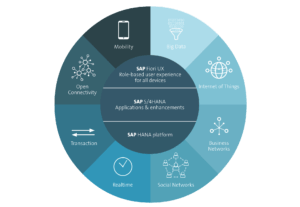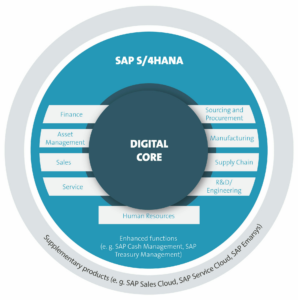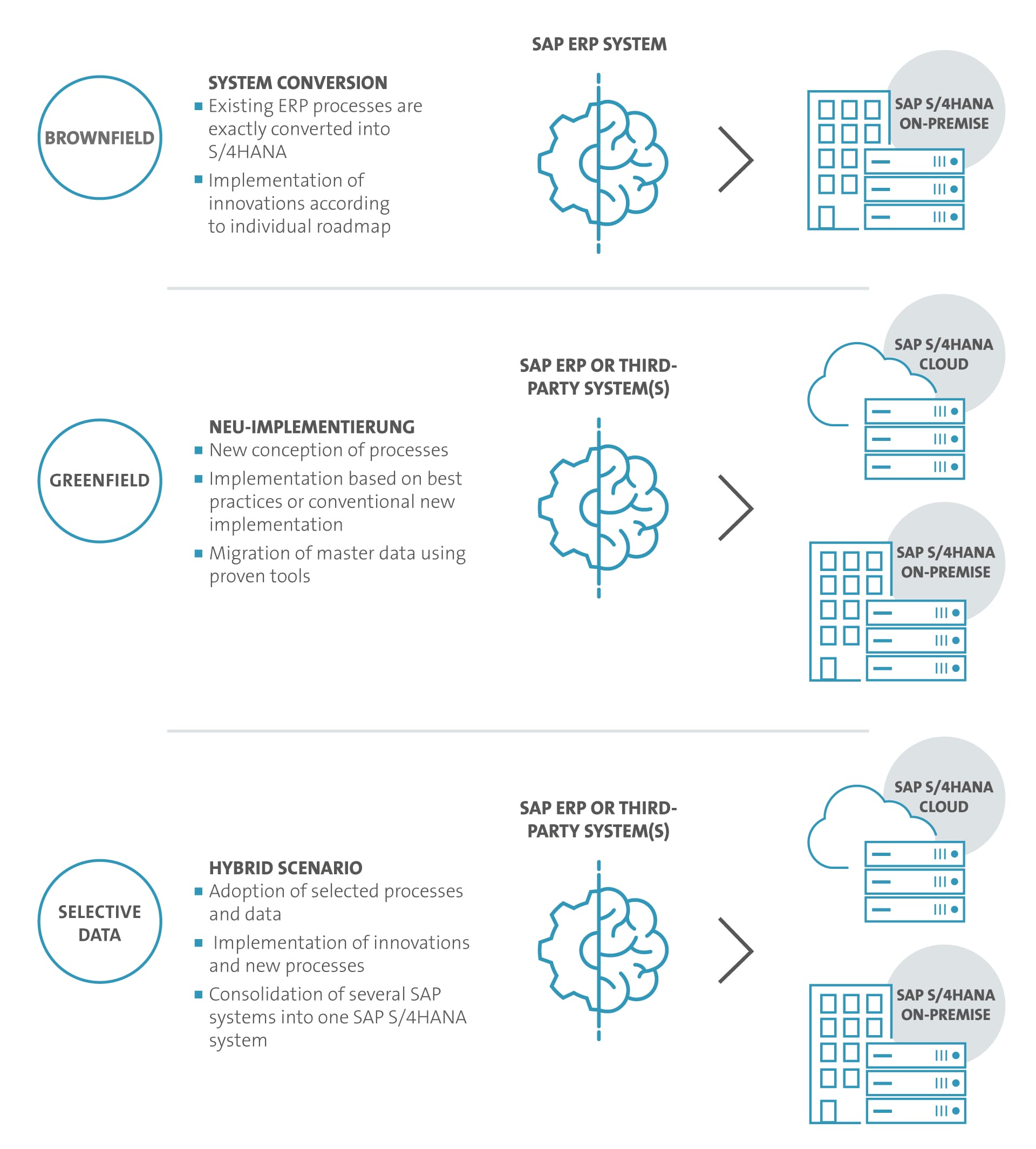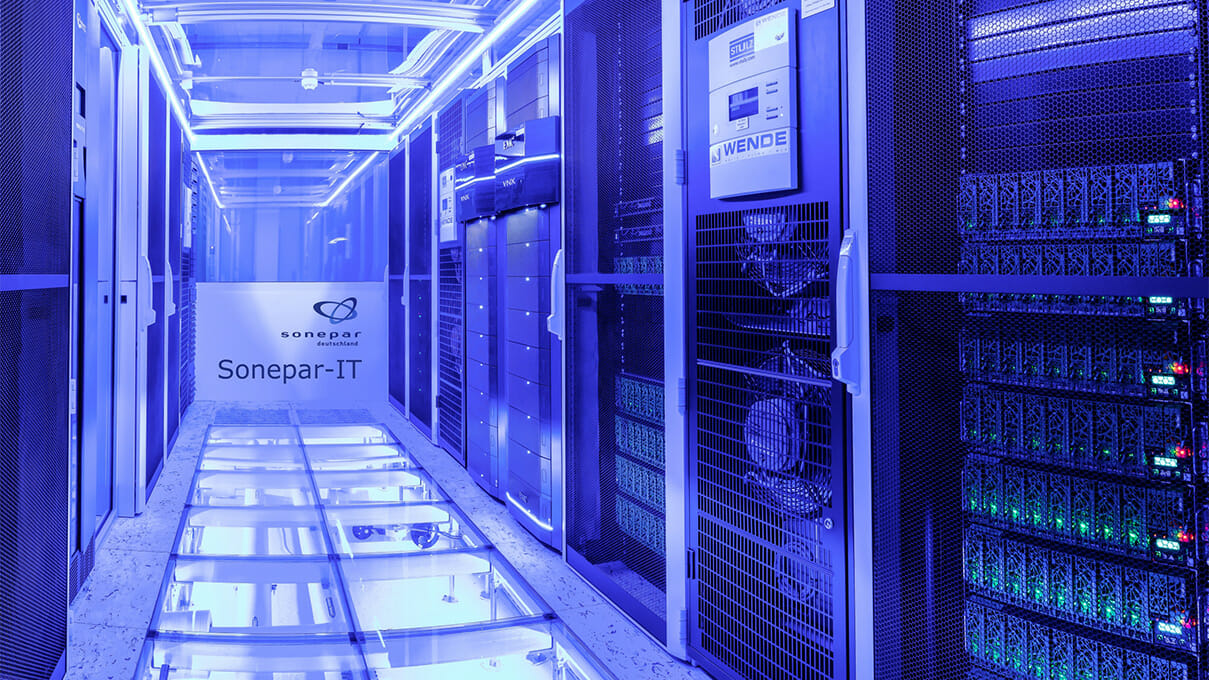In times of “big data”, data is an important production factor for enterprises. However, the datasets to be processed are enormous. Data, key figures and processes must be analyzed and provided in real-time to ensure that decision-makers better understand requirements and customer needs and have a solid basis for future decisions. The real-time SAP S/4HANA ERP Suite – based on the HANA in-memory database – is the appropriate ERP software in this case enabling all applications mentioned above and involving new and user-friendly functions for your enterprise.
SAP S/4HANA – WHAT IS THIS?
SAP S/4HANA is the latest generation of the SAP ERP system and has replaced SAP ERP ECC. The solution supports companies on their way to become intelligent enterprises.
SAP S/4HANA ERP was developed on the basis of the SAP HANA database. The advanced in-memory technology simultaneously uses the working memory as a data store and, in this way, enables data processing in real time – even in large volumes.
With SAP Fiori, users obtain a role-based and intuitive user interface enabling a flexible use across all devices and guaranteeing easy operability.
When implementing the new ERP solution, enterprises can choose between SAP S/4HANA Cloud (public cloud or private cloud), an on-premises version or a hybrid approach.
With SAP S/4HANA, users benefit from fast systems and processes, real-time data and an intuitive user experience.
INTERESTING DOWNLOADS
Sonepar gets ready for the future with a changeover to S/4HANA
What are your BENEFITS WITH SAP S/4HANA
- Designing the future: Promote the digitization of your business processes and make your business fit for future challenges with S/4HANA!
- Planning security: A well-arranged reporting gives you as a user a clear overview of company-wide output patterns and corporate developments.
- Real-time insights: Analyze business data and key figures of defined periods and evaluate changes within a few seconds.
- Cost reduction: Due to the reduced S/4HANA memory requirement, you significantly streamline the volume of your IT landscape and capacities.
- Sales optimization: Use S/4HANA for an easy adjustment of your product placement to current sales figures and stock data. This will increase your company’s sales opportunities and stock shortfalls can be avoided.
- Improved user-friendliness: With SAP Fiori apps and user interfaces that can easily be applied on all devices you will execute all arising tasks flexibly and on the move. The user experience improves significantly. Information is formatted graphically within seconds so that you can react immediately and irrespective of your location.
- Slim technology: The in-memory technology based on the SAP HANA database is built on one single central data basis. This simplified data model reduces efforts for data maintenance, backup and consolidation and creates further potential for cost reductions in the software and hardware area.
SAP S/4HANA simply explained – DIGITAL CORE & LINES OF BUSINESS
What is the “digital core”?
Vendor, business partner, customer or machine data can be processed in real time in the “digital core”. Any information gained is integrated into SAP S/4HANA and can be directly used. Therefore, the “digital core” is the centerpiece that directly provides the system data and, as a consequence, the central component of an advanced, open and customer-centered IT architecture. The basic functions required for an SAP system and for enterprises can be found in its center, whereas enhanced functions are located outside the core, i.e. as separate business area solutions or lines of business. In this way, the “digital core” remains as slim as possible. Here, the new architecture is structured in such a way that further systems or non-SAP systems can optimally be integrated.
What are the “lines of business”?
The SAP Lines of Business (business area solutions) replace the modules known from SAP ERP and include functions and processes for individual business areas. These business area solutions are enhancements for the “digital core” with an additional functional scope.
Here, you will learn more about the respective business area solutions:
What are the benefits of SAP S/4HANA OUT OF THE CLOUD?
Today, enterprises are faced with the choice between an on-premises system, operation in the cloud or a hybrid approach when implementing SAP S/4HANA.
The ERP system operation in the cloud provides several advantages:
- Data silos are broken down as users can access all information irrespective of their location. This creates efficient procedures and enables seamless cooperation.
- SAP S/4HANA Cloud provides best practices for selected industries and standardized presettings, which tremendously reduces the implementation time.
- The cloud version is open for new technologies. As a consequence, AI and machine learning as well as predictive analytics can easily be used.
- As the cloud solution is operated on SAP servers or in hyperscalers, no separate IT infrastructure is required any longer, which minimizes initial investment.
- SAP assumes responsibility for administration, governance, infrastructure, maintenance and updates for cloud applications. Therefore, the IT department can focus on further developing the business processes.
- Today, cloud solutions provide a high degree of data security and data protection because strict rules apply making data safe in German computer centers.
If you make a decision in favor of SAP S/4HANA in the cloud, you can choose between two operating models: private and public cloud.
The Private Edition of SAP S/4HANA Cloud unites the cloud benefits of standardization and scalability with the full functional scope and the extensibility of the classical SAP S/4HANA software. The public variant is ready for use particularly quickly as it is a completely new implementation which requires no individual programming. Enhancements and adjustments can only be made here within the S/4HANA Extensibility Framework or via SAP BTP (Business Technology Platform).
Detailed information on the different cloud solutions and their benefits can be obtained here.
Greenfield, brownfield or Selective Data – FINDING THE RIGHT SAP S/4HANA ROADMAP
SAP user companies should soon change over to the new ERP SAP S/4HANA system because enhanced support for SAP ECC expired in 2023 and free support will end in December 2027.
If you are planning to switch to SAP S/4HANA, there are some preparatory measures that you can implement already today. Implementing these steps provides you with considerable advantages later in the transition project and allows you to enjoy many functions of the SAP S/4HANA world already now in your current SAP landscape.
A particularly important step in project preparation is the decision on the transition scenario. When implementing S/4HANA, you can choose between three options as to how the existing SAP ERP system is to be transitioned and migrated:
- Greenfield (digital restart on the green field): complete replacement of existing systems by implementation of a new SAP system
- Brownfield (system conversion and upgrade): stepwise migration of the existing SAP systems to S/4HANA
- Selective Data Transition: the hybrid approach as a middle course
Advantages of the greenfield approach:
- Restart possible
- Use of innovations
- Re-standardization
- Optimization of the system landscape
Advantages of the brownfield approach:
- Reduced and more predictable effort (support, training, project duration)
- Modernization and consolidation
- Integration into the existing system landscape
- Know-how remains
- Individual customer processes are adopted
Advantages of Selective Data Transition:
- Combines the advantages of greenfield and brownfield
- Consolidation of several single systems into one system is possible
- Migration of (selectively) relevant business data
- Adoption of processes and successive adaption of process (innovations)
When choosing between these three approaches, there is no “best way”. The decision in favor of your specific SAP S/4HANA Roadmap is mainly based on your individual initial situation and the following two questions: What is your status quo and what are your future requirements? SAP tools provide a first tendency for an appropriate way. However, an exact evaluation and decision-making require a more detailed analysis in a separate workshop.
If you have chosen a way of transition, you should think about the operating and license model of the future. If you choose SAP S/4HANA Cloud, the “RISE with SAP” offer will help you reach the new SAP world efficiently.
SONEPAR GETS READY FOR THE FUTURE – Successful changeover to S/4HANA
Why is the use of SAP Fiori recommended?
With the increasing popularity of mobile devices, the private user behavior has significantly changed, which also affects the daily professional routine. A better usability of business applications is required. Users expect easy-to-operate user interfaces that are available on any device in the office (on PCs) or on the move (on Smartphones or tablets).
SAP Fiori is a user experience specifically developed for this purpose to enable operator-friendly, role-specific and browser-based user interfaces. With the SAP Fiori app collection, you can considerably accelerate ERP workflows, simplify and complete them on the move. Even for power users processing a comprehensive range of applications and tasks in SAP ERP, an adequate and comfortable environment is now provided.
Advantages of the Fiori apps:
- Modification of the user interface depending on the role – for a quick and easy access to information
- Visually appealing user interfaces – providing precisely the information required by the respective users
- Automation option for repetitive processes
- Avoidance of costs for previously conventional programming of user interfaces
- Reduction of training efforts for your users
- Individual adjustment of layouts, fields and functions
FAQ on SAP S/4HANA
Interested in SAP S/4HANA? Request personal consulting
Request now for SAP S/4HANA – free of charge and without any obligation!
You are currently viewing a placeholder content from HubSpot. To access the actual content, click the button below. Please note that doing so will share data with third-party providers.
More InformationFurther services by FIS for efficient SAP processes
Downloads
Do you have any more questions regarding the real-time ERP SAP S/4HANA system or would you like to learn more about further possible applications of SAP technologies in your company? Contact the FIS SAP consultants – the experts will be pleased to assist you on your way to digital S/4HANA transformation.


















